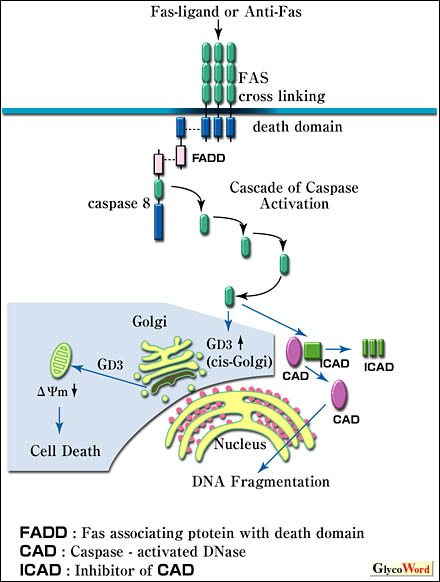|
Glycosphingolipids and Apoptosis
|
|
|
 |
Apoptosis is a type of cell death distinguished by morphological differences from another type of cell death called necrosis, or cell death that occurs passively under pathological conditions (1). Cells dying by apoptosis are characterized by shrinkage of cells and condensation and fragmentation of the nuclei, followed by the formation of small, roughly spherical or ovoid cytoplasmic fragments, some of which contain pyknotic remnants of nuclei. These fragments, apoptotic bodies, are quickly phagocytosed by macrophages and neighboring cells.
Biochemically, chromatin DNA is fragmented at the level of the nucleosome in apoptosis. This type of cell death is seen in cells that are no longer necessary during development and even after the completion of development, or when harmful cells are generated by viral infection or damage to DNA. Therefore, apoptosis is considered to be active or spontaneous cell death for self-regulatory and self-defense purposes, and cells seem to be programmed to kill themselves.
It is known that caspase, a family of cysteine proteases, plays a key role in the triggering of apoptotic cell death. If apoptosis is triggered, a cascade of caspase activation takes place leading to decomposition of various intracellular proteins and fragmentation of DNA by DNase which is activated by a caspase. Although the main signal transduction pathway that activates the caspase family has been reported in the apoptosis triggered via Fas-Fas ligand system (2), factors that are involved in the induction of apoptosis and the mechanism of apoptotic cell death differ among different cells and also according to the condition of the cells.
Along with the finding that the sphingolipid ceramide acts as a signaling mediator of some types of apoptosis, the possible involvement of the sialosphingolipid ganglioside in apoptosis has been reported. A transient increase in the level of ganglioside GD3 is observed in human cutaneous T cell lymphoma cell line HuT78 cells and in human monocytic leukemia cell line U937 cells when caspase is activated by cross-linking of Fas. Since GD3 can decrease the mitochondrial membrane potential (˘µm) and trigger apoptosis by itself, it seems that GD3 acts as a mediator in the downstream portion of the caspase-dependent cascade reaction that induces the development of apoptotic cell death, probably by changing mitochondrial function (3). It was also found that the increase in the level of ganglioside GM3 induces the differentiation of human colon cancer cells to mature epithelial cells and causes apoptosis, or spontaneous cell death, as a consequence of terminal differentiation (4).
Although this study was started recently and the detailed mechanism is unknown, gangliosides were found to be involved not only in the regulation of cell proliferation/differentiation, but also in the induction of apoptosis. These findings suggest that gangliosides play a key role in the maintenance of homeostasis of the body, and research on gangliosides will provide us with a new therapeutic approach towards cancers. Further studies on this subject are awaited.
|
|
|
 |
|
|
Hisao Nojiri (Faculty of Pharmaceutical Sciences, Teikyo University) |
|
|
|
|
|
| References |
(1) |
Kerr JFR, Wyllie AH, Currie AR Br. J. Cancer, 26, 239-257, 1972 |
|
(2) |
Nagata S Cell, 88, 355-365, 1997 |
|
(3) |
De Maria R, Lenti L, Malisan F, dĠAgostino F, Tomassini B, Zeuner A, Rita Rippo M, Testi R Science, 277, 1652-1655, 1997 |
|
(4) |
Nojiri H, Manya H, Isono H, Yamana H, Nojima S FEBS Lett., 453 , 140-144, 1999 |
|
|
|
|
|
| Sep.15, 1999 |
|
|
|
|
|
|
|



